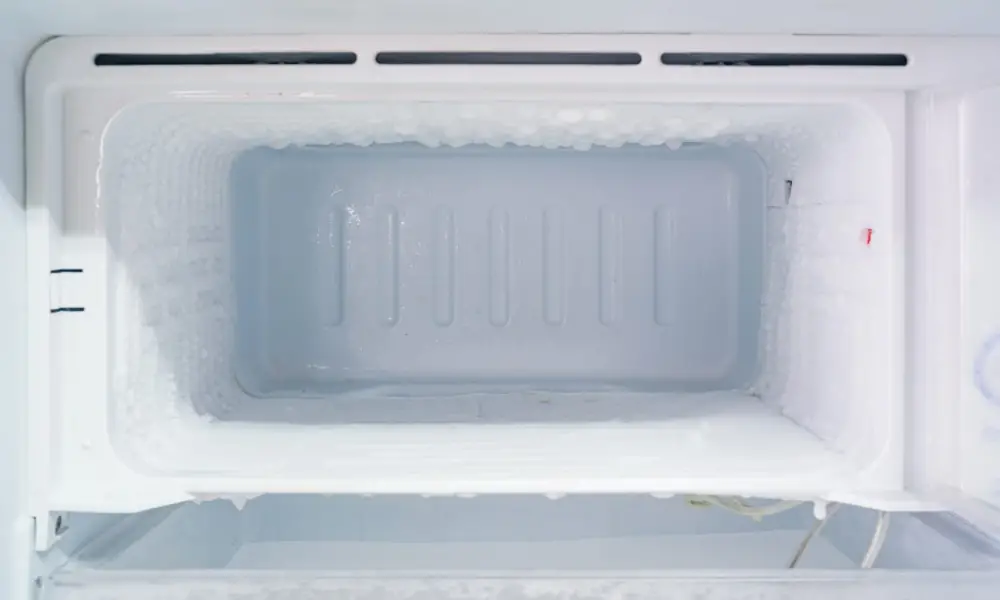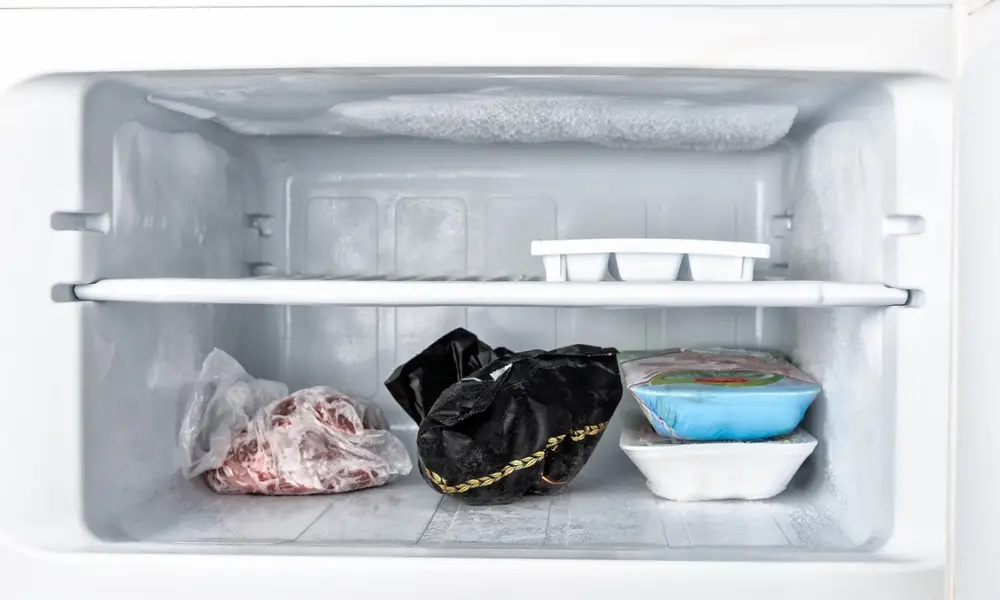A manual defrost freezer is a great appliance to have in your kitchen. It is simple to use and can save you a lot of money on your grocery bills. However, there are some factors that you need to consider before purchasing one.
When choosing the right type of freezer, you must decide whether to get an automatic or manual defrost unit. Both types are effective and efficient but have different nuances that should be considered. A manual defrost unit has copper tubing strategically placed around the interior walls, which serves as an evaporator. It is also quieter. But manual defrosts freezers can be messy. There are a few different models that you can choose from. Some are more expensive than others. Choosing the right model can be important for your freezer’s operation and maintenance.

What is Manual Defrost Freezer?
Key Feature
There are no mechanical heating elements in a manual defrost freezer to stop the accumulation of frost or ice. As the ice accumulates, the owner must manually defrost the freezer coils. Too much ice and frost on the coils restricts airflow, which prevents the freezer from effectively cooling food.
Appearance
Most chest freezers contain a manual defrost feature, albeit not all do. A chest freezer with manual or self-defrost would typically need an additional flat floor area. Additionally, chest freezers lack the upright self-defrost model’s organizing potential and retrieval convenience.
Repair and Maintenance
Typically, it is advised to defrost a freezer after the frost has grown between a quarter-inch and a half-inch thick. Manually defrosting a freezer is a laborious, time-consuming operation. To expedite the procedure, the appliance must be unplugged before everything is taken out of the freezer and large chunks of frost are pulled off. With manual defrost, a bottom drain to release the water is often present in chest freezers.
Noise
Self-defrosting refrigerators tend to be noisier than manual-defrosting freezers. All you’ll hear throughout the day is the compressor and perhaps the regular expansion and contraction of the freezer liner.
Energy Use
Two things cause the energy-saving element to happen. First, a chest freezer has a low rate of cold air loss (usually manual defrost). Much less cold air may escape via the door than a front-opening door since it opens from the top of the chest. A manual defrost freezer also keeps its freezing temperature more consistent. Even though manual defrosting and freezers need more cleaning, they are less expensive to purchase and use less energy.
Cost
Due to fewer components, a manual defrosts upright freezer of the same size as a self-defrosting type will cost a little less. Even less expensive than a manual defrost upright freezer is a manual defrost chest freezer roughly the same size (in cubic feet).
Installation
Installation is the same whether the freezer is self-defrosting or manual defrosting. Generally, a freezer must always be connected to a separate outlet with the proper voltage. No matter how well it defrosts, this will give your freezer optimal performance.
Lifespan
You may have heard that freezers have a 20-year lifespan. The truth is that your appliance will survive between 10 and 14 years, whether you have a self-defrosting or manual defrost freezer.
How to Manually Defrost the Freezer?
Step 1: Turn off your refrigerator’s power
Remember to unplug your refrigerator from the power source before you begin cleaning. It’s wise to relocate your refrigerator away from the wall. Cleaning will be safer and simpler as a result. To collect any drips or leaks, keep cotton towels on the floor.
Step 2: Clean out your fridge
Start by removing all of the contents from your refrigerator. Take everything out and place it all outside. Food things that could spoil should be kept in a big container. Put a lid on it and some ice cubes on top of it. Additionally, this is an excellent time to eliminate any clutter or outdated stuff.
Step 3: Remove the shelves and drawers.
Now take out every shelf and drawer in your refrigerator. However, use caution when handling these improperly; cold shelves and drawers could break. During this period, you can also clean these objects. You might use a readily accessible kitchen cleaner like Cif Kitchen Cleaner. To understand the recommended usage, consult the pack.
Step 4: Let your refrigerator breathe.
After you’ve cleaned out your refrigerator, let some fresh air in. Just leave the refrigerator door open for up to 8 hours. This guarantees specific outcomes. You can defrost the fridge if you have a whole day to spare.
Step 5: If you want to expedite the procedure.
Placing a container of hot water in your refrigerator will hasten the process, though, if you are in a hurry. Hold it in place until the water reaches room temperature. To prevent surface damage, don’t forget to place a thick cloth or a holder beneath the vessel.
Step 6: Use a hair dryer.
You can aim for larger ice pieces while the hot vessel is doing its thing. Use a medium-hot setting on a hair dryer to dry it completely. This will melt pieces of resistant ice. Keep a plastic spatula close to clear any small ice chunks.
You can remove the softened ice by sliding it into one location and removing it with a plastic spatula. Keep in mind to use spatulas lightly to avoid chipping the surfaces.
Step 7: Apply a fan
Place a fan in front of the refrigerator once that is finished. This will aid in the easy removal of the ice pieces and the evaporation of the ice water. This will hasten the defrosting procedure for you.
Advantages of Using a Manual Defrost Freezer
In manual defrost freezers, refrigerant is circulated through wall-mounted coils to create cooling (and sometimes in the shelves). In contrast to an auto-defrost freezer, the cold air circulates due to the internal temperature differential, maintaining a more stable interior temperature. However, areas towards the bottom and the wall may be a little bit cooler than other areas of the freezer.
The airflow and cooling power of the coils are restricted when condensation and ice accumulate on the walls, necessitating the need to defrost the freezer.
These freezers are preferable for open container storage because your material won’t dry up as soon. After all, there is no air circulation in them.
Freezers with manual defrost often cost less. For instance, the Premier Countertop Freestanding Freezer offers auto- and manual-defrost options, costing more than $100 less.
Since a manual freezer doesn’t need to heat coils or power fans, it should be more energy-efficient.
Since there is no coil heating, the inside temperature of manual-defrost freezers is more steady.
What are the Drawbacks of Using a Manual Defrost Freezer?
One of its main disadvantages is the impracticality of manually defrosting a freezer. The unit must be shut off, the samples must be transported, and the frost must be eliminated. In addition to being impractical, samples will be moved while being exposed to ambient temperature for a very little time. The samples cannot be reinserted until it has reached temperature.
How to Clean the Manual Defrost Freezer?
Create a Cleaning Agent
In a dishpan or bucket, combine one tablespoon of baking soda with one quart of warm water.
Clean and dry the inside of the freezer.
Use a microfiber cloth dipped in the baking soda solution to clean every inner surface of the freezer once it is empty and clear of frost.
Make sure to look for damage and clean the door’s seal. It might have to be changed.
Wash the cloth frequently to prevent the transmission of dirt and food particles.
Apply a fresh microfiber cloth to the freezer’s interior to dry it.
Keep the Outside Clean
Use the same baking soda solution to clean out dust and fingerprints from the freezer’s exterior.
Combat Odors
Odors will persist if the food is frozen and then spoiled in the freezer. To eliminate them:
Dispose of the food after unplugging the freezer.
Use a solution of baking soda and water to clean the freezer’s interior, or use a solution of one cup of distilled white vinegar for every gallon of water.
If the stink persists, put some activated charcoal in an open freezer container and keep the door closed for a few days. If the smell continues, repeat the process with fresh charcoal.
Conclusion
There are many things to consider when buying a manual defrost the freezer. These include energy efficiency, operation, and maintenance. You should also look for features such as a visual alarm or audible alarm.
Manual defrost freezers are more energy efficient than self-defrosting models. However, they can be time-consuming and messy. This means they may need periodic manual defrosting. They also tend to be less quiet than their counterparts. Choosing a manual to defrost upright freezer over a self-defrost model can save you money, as the latter requires more maintenance. If you cannot find a manual defrost model, you can also purchase an automatic freezing machine, which will require less manual work.

